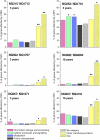Helicobacter pylori genome evolution during human infection
- PMID: 21383187
- PMCID: PMC3064335
- DOI: 10.1073/pnas.1018444108
Helicobacter pylori genome evolution during human infection
Abstract
High genetic diversity is a hallmark of the gastric pathogen Helicobacter pylori. We used 454 sequencing technology to perform whole-genome comparisons for five sets of H. pylori strains that had been sequentially cultured from four chronically infected Colombians (isolation intervals=3-16 y) and one human volunteer experimentally infected with H. pylori as part of a vaccine trial. The four sets of genomes from Colombian H. pylori differed by 27-232 isolated SNPs and 16-441 imported clusters of polymorphisms resulting from recombination. Imports (mean length=394 bp) were distributed nonrandomly over the chromosome and frequently occurred in groups, suggesting that H. pylori first takes up long DNA fragments, which subsequently become partially integrated in multiple shorter pieces. Imports were present at significantly increased frequency in members of the hop family of outer membrane gene paralogues, some of which are involved in bacterial adhesion, suggesting diversifying selection. No evidence of recombination and few other differences were identified in the strain pair from an infected volunteer, indicating that the H. pylori genome is stable in the absence of mixed infection. Among these few differences was an OFF/ON switch in the phase-variable adhesin gene hopZ, suggesting strong in vivo selection for this putative adhesin during early colonization.
Conflict of interest statement
Conflict of interest statement: M.D. is an employee of Roche Diagnostics GmbH.
Figures



References
Publication types
MeSH terms
Grants and funding
LinkOut - more resources
Full Text Sources
Medical
Molecular Biology Databases
Miscellaneous

